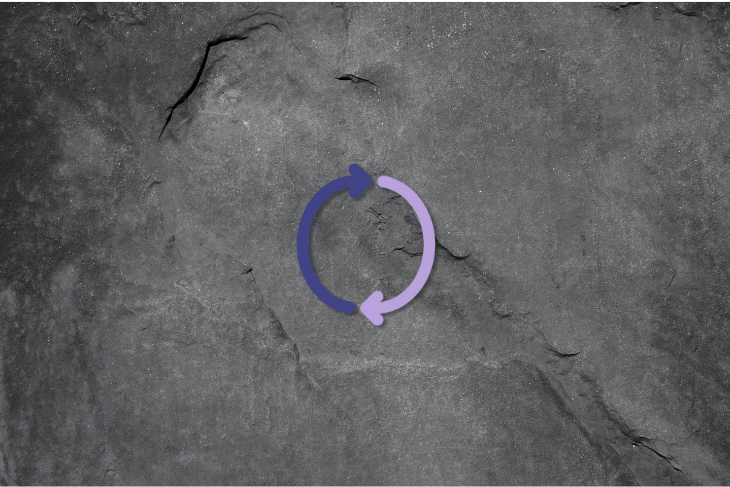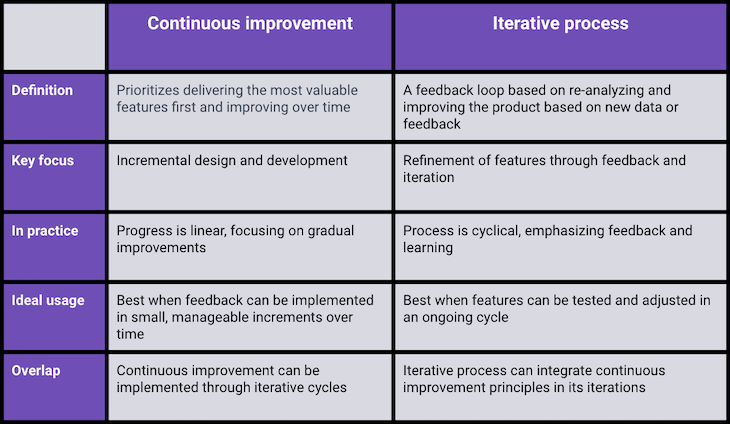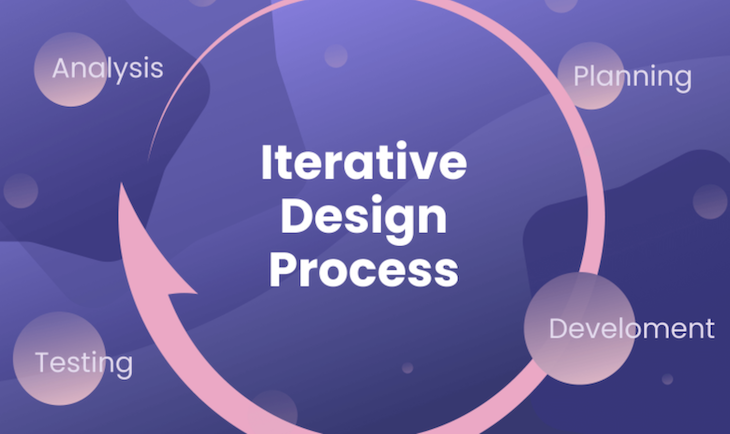In the software development industry, project managers have shifted towards using agile frameworks. Waterfall is long gone from our lives. Instead, agile utilities the iterative process for flexible software design and improved development capability.

A couple of days ago I went to buy furniture from Ikea and the salesperson drew a prototype of the product I imagined within a minute. I shared information about my room and he updated the prototype until we created the perfect match.
Even when buying furniture you can experience the iterative process by:
As a product manager, iteration means “not forcing the team to over-engineer, learning from the latest iteration, and achieving better results for later version of your product”
In this article, you will learn what the iterative process is, how it differs from continuous improvement, as well as the steps to implement the iterative process on its own.
The iterative process is a set of actions consisting of analysis, planning, design, implementation, testing, and review. This involves a continuous product improvement process of: try, learn and improve again. The main idea is to minimize the effort required for research, development, and implementation.
By dividing the process into smaller pieces, you can optimize your product and see customer results fast. The goal is to force yourself to reduce risk, manage efficiently, and create a flexible work environment.
The iterative process can be implemented into any working method, but as I mentioned, is an integral part of the agile methodology.
There’s no end to product improvement. You should divide features into small changes and prioritize the ones that will create the biggest impact. Your aim is to get a significant impact with small efforts.
The continuous improvement method originated in Japan and is also known as Kaizen. Your operational excellence team can use the method to improve the operational side of the business.
The method forces managers to interrogate every feature until they become basic ones. You can implement continuous improvement methods into your organization if you are using lean, Kanban, Six Sigma, or agile.
Most agile companies use continuous improvement and the iterative process together in tandem. After a while, people can think the two processes are the same, but there is a difference between them.
The iterative process doesn’t force you to develop primitive capabilities all the time. You have room to iterate features and create a better version of it. On the contrary, continuous improvement tends to optimize and delay resource usage as late as possible.
The iterative process is a feedback loop based on re-analyzing and improving the product according to new data or customer feedback. The product becomes better through trial and error.
Continuous improvement is also called incremental design or development. With continuous improvement, you prioritize the most valuable features first and deliver packages as quickly as possible.
If you use an iterative process in the correct way, you continuously improve your product with deliverable parts. And if you are using continuous improvement in a correct way, you listen to feedback and respond to needs in an iterative way:

The problem with non-iterative processes is that they don’t allow you to change course.
Before agile methodologies, PMs relied on waterfall methodologies, which were non-iterative processes. You divided projects into phases and after every phase was completed you started a new one. As waterfall requires, you planned your resources according to projects and wouldn’t change anything until the project was completed.
Technology companies aren’t suited to work with a fixed model. Markets can change in a minute, causing everything you build to be worthless before launch. Iterative and continuous methods offer flexibility and agile structures to ensure you don’t miss any opportunities.
In a waterfall method, a tiny requirement change causes a huge cost to rebuild and deliver. Tech companies prefer iterative processes because of their cost effectiveness. Rather than thinking about the project as a whole, thinking smaller parts at a time, helps the team to be more creative.
Iterating the process lowers the risk in many ways. Think of a waterfall project with a six months development duration. After a project is completed you would develop everything at once and if one feature has a problem you need to check everything at the same time.
Even if everything goes perfectly, you can see that the feature isn’t to customers expectations. To avoid such risks, ask for customer feedback in early stages. Finding the problem earlier is more efficient, cost effective, and also increases your customer’s happiness.
In some cases, product managers have a lack of information and data to provide a full flow. The PM and the team can provide a prototype to gauge customer reactions and usage data. While the product is in the development phase, you will have a chance to reshape your product and launch with better results.
Additionally, customers are more happy with the iterative process because they can get improvements earlier. There’s no need to wait six more months for a tiny upgrade. This method helps you to have clear communication with customers and encourage them to provide feedback.
The iterative process starts from product ideation and continues as a software development life cycle. The steps are as follows:

Analysis is important to eliminate risk factors before starting to implement features. You need to analyze the product market and understand customer pain points. As a product manager, you convert the customer needs into technical requirements in this phase.
Determine high level requirements and possible solutions for the product with the development team. You can arrange a brainstorming or an event storming activity for the software team to have more ownership of the product.
Choose the scope and your product objectives. The scope contains the features that provide the most value to the product according to your forecasts. Prepare the requirement set and discuss value propositions of requests.
The iterations should be planned according to customer expectations, and must have capabilities so that you don’t lose customers.
The development team starts to prepare the implementation of the first iteration after the planning phase. Your role here is to make sure everything goes as expected. Answer the development teams’ and customers’ questions as needed.
Testing methods can differ according to the features you deliver and your company policies. After QA approval, you should test the iteration before deployment. Demo sessions can be arranged with business teams and customers to show off the product and collect feedback for later iterations.
As a PM, the first thing you should consider is your customer base. Arrange iterations according to customer expectations, feedback, and value propositions.
For example, if you want to see if a feature will create an impact or not, you can easily create a prototype iteration and ask customers for feedback. There’s no need for a full set of features, a simple capability will show you the result.
Create a continuous feedback loop with your customers. For B2C products it is easy to implement, because you have app stores, comment and support operations.
You should answer messages because entries without an answer may create a bad impression. Each customer will have a different perspective for the product and your prioritization mechanism will be based on the amount of customer requests.
You should be as flexible as you can. Nobody can insist on developing a feature if they see the previous iteration metrics. The data you collect will help you determine whether a feature has value.
Learn from each mistake. You can host “retro” meetings after every iteration process, where the business team, customers, integrated teams, and anyone else can enter a comment to discuss potential failures.
You can not be successful if you ignore the mistakes you made on an iteration. Add lessons learned pages into your product/project documentations, so that everyone can see them while iterations are on going.
Before concluding, I want to leave you with the SMART approach. Agile processes offer less for analyzing and defining requests, so you should be as SMART as possible. SMART stands for:
These five bullets are practically a summary for the iterative processes. You need to set robust goals to achieve within a short time range and you need to impress customers with prototype’s of features.
Focusing on SMART goals will help you focus on little pieces of the puzzle, instead of trying to do everything at once. As a result, you will achieve your iterations, while making it easier to review your goals.
Try to be more specific instead of perfect. Leave room for creativity and improvements.
Featured image source: IconScout

LogRocket identifies friction points in the user experience so you can make informed decisions about product and design changes that must happen to hit your goals.
With LogRocket, you can understand the scope of the issues affecting your product and prioritize the changes that need to be made. LogRocket simplifies workflows by allowing Engineering, Product, UX, and Design teams to work from the same data as you, eliminating any confusion about what needs to be done.
Get your teams on the same page — try LogRocket today.

A practical five minute revenue estimation method to help product managers compare ideas, drop low impact features, and prioritize smarter.

A practical guide for PMs who want to stop being bottlenecks, delegate smarter, and lead teams effectively with a clear ownership framework.

Stop letting unreliable data block features. Treat data as inventory to track quality, ownership, and ship with confidence.

Learn why slide decks slow teams down and explore better tools like whiteboards, PRDs, and prototypes to improve collaboration and alignment.